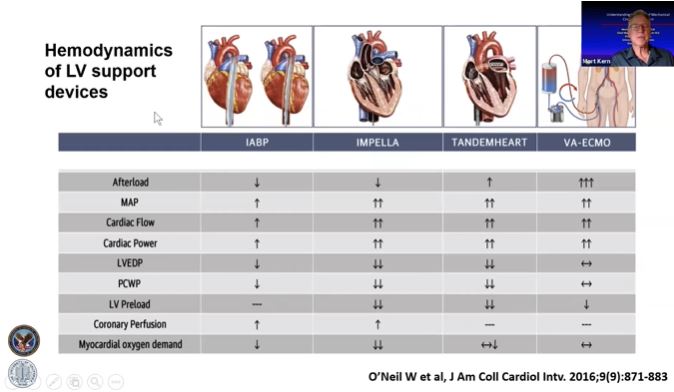17For Part 2 of our #Tweetorial on the basics of mechanical circulatory support (MCS), we will look at different device options. 🦾⚙
18We are in a wonderful time when we have many different devices available to us, so it is worth looking at the differences in these devices and what they can & can’t do. ⚖ 

19The balloon pump 🎈 produces counter-pulsation in the aorta, inflating during diastole, deflating in systole. It can be left in place for days & is relatively small. It requires cardiac synchrony or a rhythm to really function well.
Its output is modest at 0.5 L/min.
Its output is modest at 0.5 L/min.

20 The Impella is a transvalvular microaxial flow pump⛽ that draws blood from the LV into the Ao across the aortic valve. It has variable sizes & powers & can be used in pts for a couple of days or several weeks. It provides continuous flow independent of the cardiac rhythm. 

21VA-ECMO is the largest & most powerful systemic circulatory support device, drawing blood from the RA or IVC & delivering it to the Ao. It can be in place for weeks. It has a big cannula so big arteries are needed. No synchrony with rhythm is required. 

22Tandem Heart draws blood from the left atrium putting into the Ao. It can be in place for a week or more. It has a large cannulae so large vascular sizes needed. 🚫rhythm dependent. Device provides blood to the Ao like ECMO. It uses transseptal access to place the cannula. 

23The hemodynamics of these devices also vary because of their mechanisms. 🔩
24We want decreased afterload, which we get with IABP & Impella, but afterload increases with devices that deliver blood to the Ao or FA like Tandem & ECMO. Sufficient pressure can close the AV & the heart must pump against that. 

25LVEDP can decrease with IABP but is markedly decreased with Impella & TandemHeart. Marginally so with VA-ECMO, because it removes blood from the right heart, but increases LVEDP with ⬆ afterload & the inability of the Ao to open. 💗 

26The wedge pressure is reduced even more with Impella & the Tandem Heart.
27For coronary blood flow, no device can push blood satisfactorily through a very tight coronary stenosis – not IABP or Impella. But with lower LVEDP & unloading the collateral flow to ischemic regions may increase.
28Impella & IABP increase diastolic coronary perfusion pressure. Arteries with moderate narrowing will benefit & both devices can improve collateral flow to an occluded vessel or region. 🚿 

29Key to device selection is optimizing myocardial oxygen demand to hemo support. This is reduced with IABP, reduced more with Impella, marginally reduced with Tandem Heart, & not reduced with VA-ECMO because of the inability to have the heart pump against an open valve.⚖ 

30Here we see the cardiac output of these devices in perspective to each other, with overlapping pump flow rates. Not many patients need 5-7 L of output so in the middle range we can choose devices that do other things in addition to increasing CO. 🤹♀️ 

31This concludes part 2 of this #Tweetorial on the Basics of MCS.
Thanks for joining & stay tuned for part 3, when we will look at PV loops. ➰
@WondrMedical @abiomed #cardiotwitter #cardionerds @CardioNerds
@SCAI
Thanks for joining & stay tuned for part 3, when we will look at PV loops. ➰
@WondrMedical @abiomed #cardiotwitter #cardionerds @CardioNerds
@SCAI
• • •
Missing some Tweet in this thread? You can try to
force a refresh













